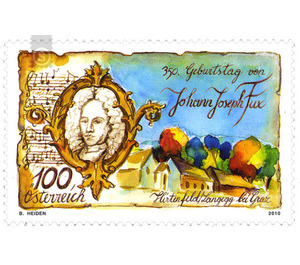350th birthday - Austria / II. Republic of Austria 2010 - 100 Euro Cent
Theme: Art & Culture
| Country | Austria / II. Republic of Austria |
| Issue Date | 2010 |
| Face Value | 100.00 |
| Edition Issued | 250,000 |
| Printing Type | offset |
| Stamp Type | Commemorative |
| Item Type | Stamp |
| Chronological Issue Number | 2215 |
| Chronological Chapter | OOS-OE2 |
| SID | 401406 |
| In 57 Wishlists | |
On the occasion of the 350th anniversary of the birth of the Austrian music theorist and composer Johann Joseph Fux, this special stamp will be published. Personal details: Born in 1660 in Hirtenfeld near Graz (the exact date is unknown), the farmer's son first studied at the University of Graz and from 1683 to 1687 in Ingolstadt. In 1696 he was appointed organist at the Schottenstift in Vienna and retained this post until 1702. In this function, the imperial court became aware of Fux and appointed him soon as the "court composer". In 1701 he was also Kapellmeister at St. Stephen's Cathedral. A few years later, in 1711, he received one of the highest offices in European musical life: he became music director of the court. Of his numerous operas and oratorios, which he wrote over the years, the opera "Costanza e Fortezza" gained the greatest fame; this was in 1723 in Prague on the occasion of the coronation of Emperor Charles VI. listed as King of Bohemia. Far more significant and sustainable than Fux's compositions is, of course, his theoretical work; his extensive compositional theory "Gradus ad Parnassum" was first published in 1725. This elementary work written in Latin - a textbook on the basics of composition - was translated into German in 1742 by Lorenz Christoph Mizler, a pupil of Bach. It had a significant influence on the so-called "Viennese School" (music style in the second half of the 18th century between late Baroque and Viennese Classical) and served until the 20th century as the textbook of counterpoint perchance. In his later life - after the death of his wife, with whom he was married for 35 years - Johann Joseph Fux mainly composed sacred music. On February 13, 1741, the great musician died at the age of 81 in Vienna. Fux's wide-ranging musical work includes numerous operas, masses, requisitions, vespers, psalms, oratorios and partisans. In contrast to his theoretical work "Gradus ad Parnassum", however, his musical works quickly fell into oblivion - only Ludwig von Köchel discovered Johann Joseph Fux again and published a biography and a catalog raisonné of the old master. Much later, some of Fux's works were published in the series "Monuments of Music in Austria". In Graz, the Johann Joseph Fux Conservatory still remembers this great Austrian musician today.


